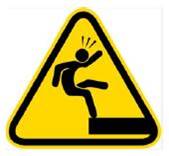Title Page
-
Work Activity
-
Workplace/Location
-
Conducted on
-
Verifier (Name) and Signature
Verification Criteria
1. Risk assess work to identity risk of falling:
-
a) Has the work been planned so that as much as possible is done at ground level (the safest option)?
-
b) When work at height (or to a depth) is necessary, have fall protection measures been identified in accordance with the hierarchy of controls?
-
c) Has a work at height work permit been issued and is it clearly understood?
2. Work from a solid, stable, fall-protected structure:
-
a) Is the work being done on a solid footing capable of bearing the weight of the people, equipment and materials?
-
b) Is the structure used for the work fitted with handrails and edge protection?
-
c) If work is being done on a roof, has the roof been checked for structural integrity and the necessary safety precautions implemented? These can include roof support planks; skylights and openings covered; travel arrest PPE worn (to keep workers away from the roof edge) etc.
3. Use fall protection/arrest PPE systems:
-
a) Are workers fitted with fall protection PPE prior to ascending to height and is it worn at all times until back at ground level?
-
b) Is the fall protection PPE secured to certified anchor points on the lift equipment or the structure at all times?
-
c) Is the length of fall protection PPE sufficient to prevent impact with the ground when the person reaches the designated critical height?
-
d) Is all fall protection PPE stored correctly and checked and confirmed in good condition by a competent person before use?
4. Workforce trained and competent for work at heights:
-
a) Are persons required to work at height:<br>• physically capable e.g. do not suffer height vertigo etc?<br>• know how to use fall protection PPE?<br>• understand the requirements of the Work at Height Permit?<br>
-
b) Have sufficient members of the work at height team been trained in emergency rescue procedures?
-
c) Do allocated spotters know how to lower lift equipment, e.g. EWP’s, in an emergency?
5. Use only certified lift equipment and/or systems:
-
a) Has the safest available lift option used to raise the workforce and materials to height (or down to depth) been determined and used?<br>• First preference: powered lift using EWP etc. of the correct safe load limit.<br>• Second preference: fixed stairs and ladders which form part of the structure.<br>• Third preference: temporary structure (scaffold) with stairs and/or fixed ladders.<br>• Last option: portable ladders (industrial to Australian Standard). Note: there may be some situations where a portable ladder is the only practical option.<br>
-
b) Has all equipment been checked as safe and serviceable before use e.g. daily prestart check of EWP’s (mainly brakes, hydraulics, bucket and structural fittings)?<br>• Have any unserviceable plant been reported and tagged ‘Out of Service’?<br>
-
c) Are operators of equipment (e.g. EWP, scissor lift etc.) trained, licensed and competent (including determining the stability of the supporting ground)?
-
d) Has any scaffolding been certified safe and checked every 7 days and the Scaff Tags applied?
-
e) Are any portable ladders properly secured bottom and top and of the correct length?
6. Eliminate the risk of falling objects:
-
a) Are tools, equipment and materials secured against being able to fall?
-
b) Has an exclusion/drop zone been established below the work at height area and clearly delineated using warning signs and physical and/or visual barriers to prevent entry by unauthorised persons?
Critical Control Effectiveness
-
Indicate the overall level of effectiveness of the Critical Control












